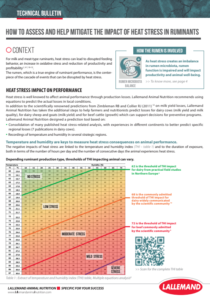Explore our program for Heat stress in ruminants
As temperatures are rising, heat stress becomes a major concern. Awareness about its impacts is growing: consequences are now seen in long-term periods, in all regions. Cattle naturally change their behavior to help alleviate stress which can disrupt digestion, increase inflammation, and reduce performance and health.
Our solutions for heat stress challenges in ruminant production
Lallemand Animal Nutrition has developed a specific approach based on nutrition with documented results to support ruminants during this challenging period.
The rumen is the centerpiece of the cascade of events that links heat stress to performance and health.
As heat stress imbalances rumen microbiota, rumen function is impaired with an increased risk of acidosis. During hot periods, feed intake can also be disrupted by the heating of the silage.
In addition to other physiological stresses due to heat, animal faces an increase in oxidative stress.
Why choose Lallemand program?
As a global leader in yeast and bacteria production, Lallemand Animal Nutrition has developed a multi-solution approach based on nutrition to help address the challenges of heat stress for dairy cows, beef cattle, as well as for small ruminants.
How to detect heat stress in ruminants?
- Shallow breathing
- Increased respiration rate
- Profuse sweating
- Reduced feed intake
- Reduced lying time
- Decreased rumination activity
- Erratic feeding behavior
Key figures about impact of heat stress on ruminants
Want to know more on how to deal with heat stress in ruminants?
Contact an expertTo go further

Technical bulletin
Learn more on how to assess and help mitigate the impact of heat stress in ruminants.
1Perdomo, M. C., Marsola, R. S., Favoreto, M. G., Adesogan, A., Staples, C. R., & Santos, J. E. P. (2020). Effects of feeding live yeast at 2 dosages on performance and feeding behavior of dairy cows under heat stress. J. Dairy Sci., Vol. 103 (1) 325 – 339
2Bach A., C. Iglesias, M. Devant and N. Ràfols. 2007. Daily rumen pH pattern of loose-housed dairy cattle as affected by feeding pattern and live yeast supplementation. J. Anim. Feed Sci. Technol. 136: 146-153
3DeVries T. J. and E. Chevaux. 2014. Modification of the feeding behavior of dairy cows through live yeast supplementation. J. Dairy Sci. 97: 6499–6510
4Lallemand Animal Nutritioninternal data. 2015. Trial performed at Texas A&M University.
5Lallemand Animal Nutritioninternal data. 2015. Trial performed at Consortio agrario del nordeste, commercial farm, DeLaTorre, Italy
6Lallemand Animal Nutritioninternal data. 2013. Commercial farm, Switzerland.
7Lallemand Animal Nutritioninternal data. 2014. Commercial farm, France 2014
8Haan M.M. Using Rumination Sensors to Monitor Heat Stress in Dairy Cows. Penn State Extension, Dairy Herd Management, November 02, 2016 https://extension.psu.edu/using-ruminationsensors-to-monitor-heat-stress-in-dairy-cows
9Dr. Kung- University of Delaware (waiting Silage team for full reference)
10L. K. Schüller, O. Burfeind , W. Heuwieser. Impact of heat stress on conception rate of dairy cows in the moderate climate considering different temperature-humidity index thresholds, periods relative to breeding, and heat load indices. Theriogenology. 2014 May;81(8):1050-7
11Based on the example of 14h/day under THI >68, average THI 69, max THI 81, august in Vietnam.
Bohmanova, J., Misztal, I., & Cole, J. B. (2007). Temperature-humidity indices as indicators of milk production losses due to heat stress. Journal of Dairy Science, 90(4), 1947–1956. https://doi.org/10.3168/jds.2006-513
Bouraoui, R, et al. The relationship of temperature-humidity indexwith milk production of dairy cowsin a Mediterranean climate. 2002. Animal Research 51(6):479-491
Hammami, H., Bormann, J., M’hamdi, N., Montaldo, H. H., & Gengler, N. (2013a). Evaluation of heat stress effects on production traits and somatic cell score of Holsteins in a temperate environment. Journal of Dairy Science, 96(3), 1844–1855. https://doi.org/10.3168/jds.2012-5947
Hammami, H., Bormann, J., M’hamdi, N., Montaldo, H. H., & Gengler, N. (2013b). Evaluation of heat stress effects on production traits and somatic cell score of Holsteins in a temperate environment. Journal of Dairy Science, 96(3), 1844–1855. https://doi.org/10.3168/jds.2012-5947
Herbut, P., & Angrecka, S. (2012). Forming of temperature-humidity index (THI) and milk production of cows in the free-stall barn during the period of summer heat. Animal Science Papers and Reports, 30(4), 363–372.
St-Pierre, N. R., Cobanov, B., & Schnitkey, G. (2003). Economic losses from heat stress by US livestock industries1. Journal of Dairy Science, 86(SUPPL. 1), E52–E77. https://doi.org/10.3168/jds.S0022-0302(03)74040-5
12Based on 13h/day under THI >68, average THI 72, max THI 85, january in Australia, Queensland. St-Pierre, N. R., Cobanov, B., & Schnitkey, G. (2003). Economic losses from heat stress by US livestock industries1. Journal of Dairy Science, 86(SUPPL. 1), E52–E77.